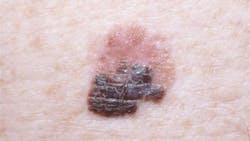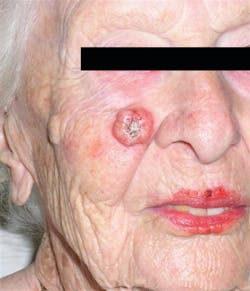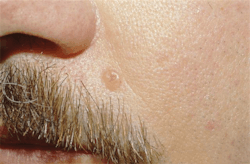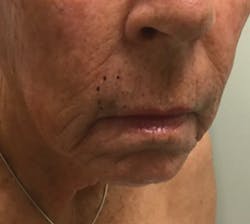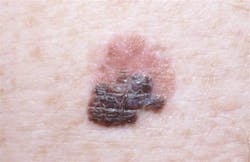As dentists, we often see our patients more than they see their dermatologist. Many patients walk around with skin pathology that they are unaware of. This is quite common in colder climates where pants and long-sleeved shirts are worn for many months of the year. We dentists have the advantage of aiding our patients and fellow physicians especially during the warmer months, the season for shorts and T-shirts.
Many different skin lesions can be present, but there are a few we can easily identify and recommend our patients visit a dermatologist if needed. Some lesions are not so easy to identify, but if they are irregularly shaped, they should be checked out. This is important as some lesions can be malignant.
The most common skin lesions a dentist should be aware of are squamous cell carcinoma, basal cell carcinoma, and melanoma.
Squamous cell carcinoma (SCC; figure 1) is not something new to us. We have been taught about it in pathology class as dental students. In addition to doing our head and neck and intraoral pathology exams, we can also observe our patient’s face and skin and examine any abnormalities. SCC on the skin presents as pink-red scaling, nonhealing lesions that often bleed. About 90% of the cases of head and neck cancer are due to SCC.1
Basal cell carcinoma (BCC; figure 2) is the most common type of skin cancer.2 It presents on the skin as a pearly pink papule that often bleeds. It can have small blood vessels over it, and it can also appear as a raised area with an ulceration.3
Melanoma (figures 3 and 4) presents as an irregular-shaped, pigmented lesion with asymmetrical borders. This lesion tends to bleed as well. About 25% of melanomas develop from moles. They most commonly occur on the legs in women and on the back in men.4
We employ the ABCDE rule for melanoma. A stands for asymmetry. B stands for border, meaning irregular border or ruffled edges. C stands for color. The lesion will have two or more different colors, and black is most concerning. D stands for diameter. One feature of melanoma is that it is 6 mm or larger. E stands for evolving or enlarging. Any lesion that is changing or growing can be suspicious for melanoma.
Other lesions may look suspicious but seem identifiable. In any of these cases, the dentist should refer the patient to a dermatologist.
References
1. Head and neck cancer. Macmillan Cancer Report website. https://www.macmillan.org.uk/cancer-information-and-support/head-and-neck-cancer. Accessed March 15, 2017.
2. Gandhi SA, Kampp J. Skin cancer epidemiology, detection, and management. Med Clin North Am. 2015;99(6):1323-1335. doi:10.1016/j.mcna.2015.06.002
3. Skin cancer treatment (PDQ)—Health professional version. National Cancer Institute website. https://www.cancer.gov/types/skin/hp/skin-treatment-pdq#section/all. Updated December 17, 2019.
4. Lian CG, Mihm MC. Skin cancer. In: Stewart BW, Wild CP, eds. World Cancer Report 2014. 3rd ed. International Agency for Research on Cancer; 2014:chap 5.14. http://publications.iarc.fr/Non-Series-Publications/World-Cancer-Reports/World-Cancer-Report-2014
About the Author

Stacy A. Spizuoco, DDS, FACD
Stacy A. Spizuoco, DDS, FACD, is a graduate of New York University College of Dentistry. She then completed a one-year advanced education in general dentistry residency. She works in private practice in New York City and volunteers as a clinical instructor at Columbia College of Dental Medicine. A national speaker, she performs charitable work and is a member of numerous dental organizations.
